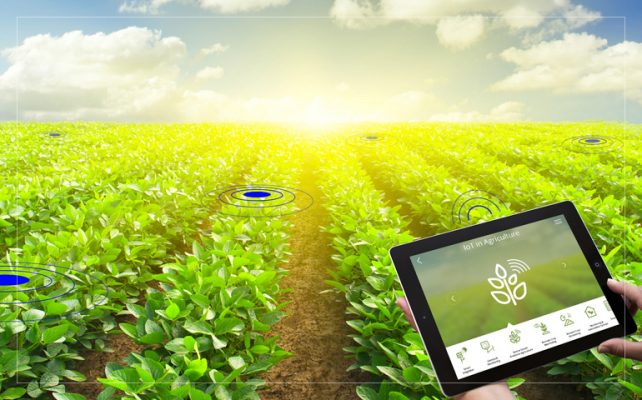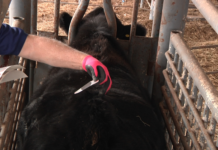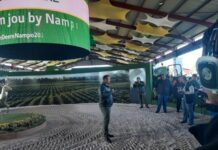The internet of things is used in agriculture to carry out precision farming, monitor livestock, and carry out smart greenhouse activities as well as in the management and monitoring of fish farms. There are various systems that contribute to the internet of things in agriculture and can be used according to the needs of that area and its production. Some of these are livestock monitoring hardware, automation, and control systems, and fish farming hardware, sensing and monitoring device, software and smart greenhouse hardware.
Agriculture is one the most important activities in most of the countries across the globe. It has evolved from manual to a technology-based occupation in every aspect. The agriculture industry is open to technical driven innovation and adoption of internet of things (IoT) for further development of the sector by using information from weather stations, sensors, and other machinery. Internet of things (IoT) can gather, use, and analyze vast amount of data that is used as an input for various algorithm-based outputs on the field for decision making. The data is used to help autonomous machines or humans to take accurate decisions to revolutionize the farming sector and deliver return on investment and tangible benefits to farmers. The primary focus of IoT is to reduce cost, save time, and decrease wastage of power. In addition, IoT in agriculture provides benefits in areas such as health, safety, welfare, sustainability, and nutrition. The application of IoT in agriculture is increasing rapidly, that includes various applications such as livestock & plant disease monitoring, yield measurement, soil conditioning, quota systems, remote machine control, mobile platform controller, computer platform controller, greenhouse management, and livestock monitoring. The application of IoT in precision farming, livestock monitoring, smart greenhouse, and fish farm monitoring has helped increase production and generate higher returns.For implying IoT to a farm land they need to have sensor networks, data analytics software, machine to machine communication, management system, and mobile or computer-based application. The complete tools of farm management coupled with information technology offer features such as critical decision capabilities that help take critical decisions at the appropriate time.
The global IoT in agriculture market is expected to witness significant growth owing to increase in global population coupled with rise in demand for food. In addition, climate change hampers agricultural production, which is expected to fuel the growth of IoT-based technology solutions in the agriculture sector. IoT-based technology is expected to increase productivity and improve efficiency of the field equipment, which further boost the market growth. Moreover, additional benefits of IoT in agriculture such as water conservation, and reduced wastage of fuel are expected to drive the IoT in agriculture market during the forecast period. However, high capital investment to develop the existing infrastructure and setup IoT in the agriculture ecosystem is a challenge for farmers across developing economies such as India, China, and Brazil. Nevertheless, increased number of smartphones and internet penetration provide up-to-date information and latest developments in the agriculture sector to the farmers. Also, these resources are available in various local languages, which is expected to boost their market growth during the forecast period. In addition, increase in public-private partnership between the government agriculture department and state-owned enterprises to promote growth of sustainable agriculture by adoption of IoT is further expected to fuel the growth of the global IoT in agriculture market during the forecast period.
The internet of things (IoT) in agriculture market is segmented based on system, application, and region. Based on system, the market is classified into automation and control systems, sensing and monitoring devices, livestock monitoring hardware, fish farming hardware, smart greenhouse hardware, and software. Based on application, it is categorized into precision farming, livestock monitoring, smart greenhouse, and fish farm monitoring. By region, it is analyzed across North America, Europe, Asia-Pacific, and LAMEA.
Some of the major players analyzed in the global internet of things (IoT) in agriculture report include Cisco Systems, Inc., International Business Management Corporation (IBM), Telit, Hitachi, Ltd, Decisive Farming, Trimble Inc., OnFarm Systems Inc., Farmers Edge Inc., SlantRange, Inc., and The Climate Corporation.
Key Benefits for Internet of Things (IOT) in Agriculture Market:
This report provides a quantitative analysis of the current trends, estimations, and dynamics of the global internet of things (IoT) in agriculture market from 2018 to 2025 to identify the prevailing market opportunities. Porter’s five forces analysis highlights the potency of buyers and suppliers to enable stakeholders to make profit-oriented business decisions and strengthen their supplier–buyer network. In-depth analysis of the market segmentation helps determine the prevailing market opportunities. Major countries in each region are mapped according to their revenue contribution to the global internet of things (IoT) in agriculture industry. Market player positioning segment facilitates benchmarking and provides a clear understanding of the present position of market players. The report includes analyses of the regional as well as the global market, key players, market segments, application areas, and growth strategies.









